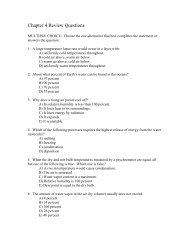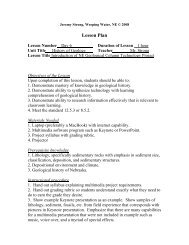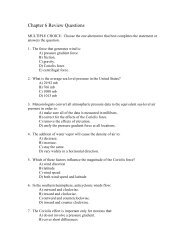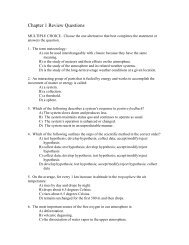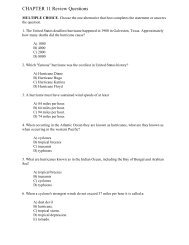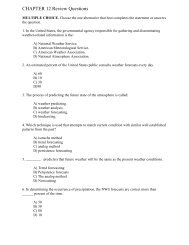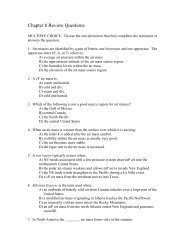Exam 2 Questions Part 1 - UNL | Earth and Atmospheric Sciences
Exam 2 Questions Part 1 - UNL | Earth and Atmospheric Sciences
Exam 2 Questions Part 1 - UNL | Earth and Atmospheric Sciences
Create successful ePaper yourself
Turn your PDF publications into a flip-book with our unique Google optimized e-Paper software.
1. No evidence existed for persistent ice on Antarctica until _____ years ago.<br />
a. 35 Million<br />
b. 55 Million<br />
c. 1 Billion<br />
d. 100 Million<br />
2. True or False: Isotopic composition of oxygen derived from foraminifer shells has changed<br />
thru time because of ice volume in continental ice sheets varies <strong>and</strong> ocean temperatures<br />
change where foraminifera live.<br />
a. True<br />
b. False<br />
<br />
3. Lighter isotope ______ more easily from the low-latitude ocean, transporting to higher<br />
<br />
latitudes leaving tropical waters ______.<br />
a. Enriched: Diminished<br />
b. Condenses: Enriched<br />
c. Condenses: Diminished<br />
d. Evaporates: Enriched<br />
4. Many climate scientists attribute global climate cooling over the last 55 Myr to falling _____<br />
levels by ______ seafloor spreading or _____ weathering.<br />
a. Carbon: Faster :Faster<br />
b. Carbon Dioxide: Slower: Faster<br />
c. Nitrogen: Slower: Faster<br />
d. Carbon Dioxide: Faster: Slower<br />
5. Where is the largest sediment mass is found?<br />
a. Atlantic Ocean<br />
b. Pacific Ocean<br />
c. Indian Ocean<br />
d. Mediterranean Sea
6. <strong>Earth</strong>’s axial tilt varies between _____ <strong>and</strong> _____.<br />
a. Doesn’t vary, always 23.5 degrees<br />
b. 22.2-24.5 degrees<br />
c. 23.1-23.9 degrees<br />
d. 21.2-24.0<br />
7. Another name for obliquity is “______”<br />
a. Angle<br />
b. Eccentric<br />
c. Tilt<br />
d. Rotation<br />
8. True or False: The non-circular shape of <strong>Earth</strong>’s orbit is the result of the gravitational pull of<br />
other planets on <strong>Earth</strong> as it moves through space.<br />
a. True<br />
b. False<br />
9. <strong>Earth</strong>’s rotational axis will eventually point to _______.<br />
a. Continue to point to the North Star<br />
b. Polaris<br />
c. Vega<br />
d. None of the above<br />
10. Our knowledge of the <strong>Earth</strong>’s orbit dates back to ____________ who lived during the 17 th<br />
century.<br />
a. Milutin Milankovitch<br />
b. Johannes Kepler<br />
c. Alfred Wegener<br />
d. Gilbert Walker<br />
11. True or False: A systematic way the impact of astronomical changes on insolation received<br />
on <strong>Earth</strong> at different latitudes <strong>and</strong> in different seasons is known as the Milankovitch theory.<br />
a. True<br />
b. False
12. According to Milankovitch, the most sensitive latitude for low insolation values is _____.<br />
a. 35 degrees<br />
b. 45 degrees<br />
c. 65 degrees<br />
d. 75 degrees<br />
13. As the Equilibrium line moves north, ice sheet formation should ______.<br />
a. Increase<br />
b. Decrease<br />
c. Remain the same<br />
14. What was the last major glacial stage episode?<br />
a. Nebraskan<br />
b. Illinoian<br />
c. Kansas<br />
d. Wisconsin<br />
15. At the maximum Pleistoncene extent, ice covered ______ the total l<strong>and</strong> area of the <strong>Earth</strong>.<br />
a. ¼<br />
b.1/2<br />
c. 1/3<br />
d. 1/5<br />
16. With every 1 degree Celsius temperature drop of the ocean, levels in the atmosphere<br />
_______.<br />
a. Rise 5 ppm<br />
b. Drop 5 ppm<br />
c. Rise 9 ppm<br />
d. Drop 9 ppm<br />
17. During glacial times, in the atmosphere declined to __________.<br />
a. 190 ppm<br />
b. 280 ppm<br />
c. 100 ppm<br />
d. 150 ppm
18. True or False: The Carbon Pump Hypothesis says that, the most productive regions in the<br />
ocean are in areas of upwelling along coastal margins, near the equator <strong>and</strong> in high-latitude<br />
surface oceans around Antarctica.<br />
a. True<br />
b. False<br />
19. Air moves freely through snow <strong>and</strong> ice in the upper _______ of an ice sheet, but is<br />
completely sealed off at ______ below the surface.<br />
a. 10 meters: 25 meters or more<br />
b. 20 meters: 40 meters or more<br />
c. 20 meters: 60 meters or more<br />
d. 15 meters: 50 meters or more<br />
20. Prominent variations in ____ at the 23,000 year cycle are linked primarily to changes in<br />
strength of the summer monsoon in tropical <strong>and</strong> subtropical regions <strong>and</strong> secondarily to variable<br />
heating of Asia <strong>and</strong> its northern wetl<strong>and</strong>s.<br />
a. Methane<br />
b. Carbon Dioxide<br />
c. Nitrogen<br />
d. All of the above<br />
21. An example of an ice-driven response is….<br />
a. Height affects atmospheric circulation<br />
b. Bright surfaces affect albedo contrast with ice-free surface<br />
c. Icebergs <strong>and</strong> melt water affect oceans<br />
d. All of the above<br />
22. True or False: Large oscillations in ice volume at a period near 100,000 years drove climatic<br />
responses that can be traced across the high <strong>and</strong> middle latitudes of the northern<br />
hemisphere.<br />
a. True<br />
b. False<br />
<br />
23. Pacific Ocean records of δ <br />
4.5 Myrs.<br />
a. Negative<br />
b. Constant<br />
c. More positive<br />
show a persistent trend toward ________ values over the last
24 . True or False: Sensitivity tests suggest a reduction of by 10% would cool even the<br />
south polar ocean, increasing its sea-ice cover.<br />
a. True<br />
b. False<br />
25. High <strong>and</strong> middle latitudes of the northern hemisphere show evidence of climate responses<br />
controlled by changes in the ______________.<br />
a. levels<br />
b. sizes of ice sheets<br />
c. Both a <strong>and</strong> b<br />
d. None of the above<br />
26. Rapid deposition of Himalayan sediments supports the hypothesis that physical weathering<br />
is stronger today on a global basis.<br />
a. True<br />
b. False<br />
27. There is a volcanic eruption in Jakarta, Indonesia (6º12’0” S). This eruption will emit<br />
particles into the atmosphere, which will be cause the climate to cool in:<br />
a. The Northern Hemisphere<br />
b. The Southern Hemisphere<br />
c. Both Hemispheres<br />
28. On July 4 th when the <strong>Earth</strong> is at aphelion, how far away is the <strong>Earth</strong> from the sun?<br />
a. 138 Million Km<br />
b. 148 Million Km<br />
c. 158 Million Km<br />
d. 168 Million Km<br />
29. When is the <strong>Earth</strong>’s Eccentric orbit the fastest?<br />
a. June 21; solstice<br />
b. December 21; solstice<br />
c. January 3; perihelion<br />
d. July 4; aphelion
30. In June <strong>and</strong> December, monthly insulation values show the prevalence of:<br />
a. Precessional changes at low <strong>and</strong> high latitudes<br />
b. Precessional changes in low <strong>and</strong> middle latitudes<br />
c. Tilt changes at high latitudes<br />
d. Both a & c<br />
e. Both b & c<br />
31. True or False: Glaciers do not retreat; instead the ice experiences ablation <strong>and</strong> melts from<br />
the front of the glacier.<br />
a. True<br />
b. False<br />
32. When looking at the growth of an ice sheet there are different facts that must be considered.<br />
Which of the following will not help in the growth of an ice sheet?<br />
a. Extremely low temperatures with frigid air<br />
b. Mean annual temperature >-10 ºC<br />
c. Mean annual temperature < 10ºC<br />
d. Both a & b<br />
e. Both a & c<br />
33. As an ice sheet grows, it will reach an elevation at which the air is very frigid <strong>and</strong> contains<br />
very little water vapor. This process will reverse which feedback?<br />
a. Elevation feedback<br />
b. Temperature feedback<br />
c. Water vapor feedback<br />
d. Glacial feedback<br />
34. Approximately 13,000 years ago, the most significant rapid climate change of the last<br />
deglaciation occurred. During this time the ice front advanced abruptly <strong>and</strong> almost reached<br />
full glaciations. What is the name given to this period?<br />
a. Little Ice Age (LIA)<br />
b. Little Dryas (LD)<br />
c. Younger Ice Age (YIA)<br />
d. Younger Dryas (YD)<br />
35. The process that seals off the air bubbles in the upper 15 meters of ice is called:<br />
a. Melding<br />
b. Dueling<br />
c. Sintering<br />
d. None of the above
36. The __________ the accumulation rate the __________, the are off set.<br />
IGNORE QUESTION<br />
a. Faster; higher<br />
b. Faster; lower<br />
c. Slower; higher<br />
d. Slower; lower<br />
37. Unlike CO 2 , methane records do not display a 23,000 year cycle.<br />
a. True<br />
b. False<br />
38. Climate change that is driven by ice sheets through icebergs <strong>and</strong> melt water is an example<br />
of:<br />
a. External forcing<br />
b. Internal forcing<br />
c. Negative feedback<br />
d. Positive feedback<br />
e. Both a & c<br />
39. During an interglacial, sea ice/ice sheets have both fast <strong>and</strong> slow inputs on the climate.<br />
What is a signal that occurs without a lag?<br />
a. Colder temperatures over Europe<br />
b. Ice sheet growth<br />
c. Decreased precipitation<br />
d. Both a & b<br />
e. Both a & c<br />
40. In the northern hemisphere, what has been the main control of climate change in the last<br />
2.75 MYR (on an orbital scale).<br />
a. Malankavich cycle<br />
b. Ice sheets<br />
c. Anthropogenic sources<br />
d. The climate has not changed in the past 3 MYA<br />
41. The net balance between accumulation <strong>and</strong> ablation over an entire ice sheet is:<br />
a. Ice growth balance<br />
b. Ice mass balance<br />
c. Equilibrium line<br />
d. Temperature balance
42. True or False: The climate<br />
point is the point wheree the equilibrium line intercepts <strong>Earth</strong>’s<br />
surface in the higher latitudes.<br />
a. True<br />
b. False<br />
43. Which of the following is true about the δ 18 O <strong>and</strong> δ 13 C during an interglacial period?<br />
a. Low δ 18 O levels <strong>and</strong> low δ 13 C levels<br />
b. Low δ 18 O levels <strong>and</strong> high δ 13 C levels<br />
c. high δ 18 O levels <strong>and</strong> low δ 13 C levels<br />
d. high δ 18 O levels <strong>and</strong> high δ 13 C levels<br />
44. One<br />
suggestion<br />
is that <strong>Earth</strong>’s climate system has a natural 100,000-year resonance,<br />
analogous to a bell that rings with a characteristic period or frequency; this<br />
is called<br />
a. Resonant responsee<br />
b. Clipped response<br />
c. Non-linear response<br />
45. When looking at δ 18 O records for the past 2.75 Myr, records show numerous cyclical<br />
variations drifting towards more positive values. Why do the δ<br />
18 O values become more<br />
positive with time?<br />
a. Because the temperatures are getting warmer<br />
b. Because the temperatures are getting colder<br />
c. Because more ice sheets are melting releasing more<br />
δ 18 O into the atmosphere<br />
46. For<br />
this problem<br />
use the figure below. Which of the following<br />
explains what is happening<br />
in stage 3 of the cycle of ice<br />
growth <strong>and</strong> decay?<br />
a. Insulation drops, equilibrium<br />
line shifts south, ice<br />
sheet starts to grow<br />
b. Insulation at a minimum, ice sheet grows rapidly, ice<br />
depresses bedrock<br />
c. Insulation rises, equilibrium line moves north, ice<br />
sheet at maximumm size, bedrock depression increases<br />
d. Insulation at a maximum, equilibrium linee moves<br />
north,<br />
ice melts rapidly, bedrock starts to rise
47. During glacial maxima, there is a large CO 2 reduction in the atmosphere, vegetation on<br />
l<strong>and</strong> <strong>and</strong> at the ocean surface. Where was the CO 2 stored during this time?<br />
a. Ocean mixing layer<br />
b. Sea ice<br />
c. Glacial ice sheet<br />
d. Deep ocean<br />
48. Primary productivity of carbon is highest in _______ ocean regions <strong>and</strong> high latitudes,<br />
with the lowest productivity found in ________ ocean regions.<br />
a. Deep; polar<br />
b. Shallow; polar<br />
c. Deep: central<br />
d. Shallow; central<br />
49. Four independent records show nearly identical long-term warming trends. While the<br />
temperature records show a similar trend, the temperature records differ slightly because<br />
the point of reference that each group uses to calculate the global temperature is different.<br />
It is not possible to reliably calculate absolute global average surface temperatures, so<br />
scientists instead calculate a relative measure called a:<br />
a. Temperature average<br />
b. Temperature anomaly<br />
c. Temperature equivalent<br />
d. Temperature fluctuations<br />
50. True or False: When insolation drives climate change on <strong>Earth</strong>; fast responding parts of the<br />
climate system track well, while slow-responding parts lag.<br />
a. True<br />
b. False<br />
51. What causes changes in Oxygen Isotope Ratios?<br />
a. Changes in Ice Volume<br />
b. Changes in the Ocean Temperature<br />
c. A & C<br />
d. None of the above
52. Which type of Foraminifera is indicative of oxygen ratios <strong>and</strong> temperatures within the<br />
deep ocean?<br />
a. Planktic<br />
b. Mesozoic<br />
c. Paleozoic<br />
d. Benthic<br />
53. Why is sea floor spreading not a valid hypothesis for the global cooling seen over the past<br />
55 Myr?<br />
a. In the last 15 Myr the rate of spreading increased but the climate cooled.<br />
b. The earth warmed over the past 15 Myr while spreading rate increased.<br />
c. Before 40-30 Myr ago the rate of spreading decreased but the earth cooled.<br />
d. Sea floor spreading has no correlation with atmospheric temperatures.<br />
54. Which of the following is not a prediction of the Uplift Weathering Hypothesis?<br />
a. Terrain today is higher than it was at earlier times in <strong>Earth</strong>’s history<br />
b. Rates of chemical weathering are higher leading to higher CO2 levels<br />
c. There is an increase in physical weathering worldwide<br />
d. Rates of chemical weathering are higher <strong>and</strong> CO2 levels have decreased<br />
55. What is true of an explosive volcanic eruption in the tropics?<br />
a. <strong>Part</strong>icles stay near the equator <strong>and</strong> global impact is limited.<br />
b. The hemisphere that feels the greatest impact depends on prevailing winds.<br />
c. The climatic response is global because ash spreads throughout both hemispheres<br />
56. True or False: The earth’s elliptical orbit has a very large effect on the season.<br />
a. True<br />
b. False<br />
57. What is the period of the changes of the tilt of the earth’s axis?<br />
a. 21,000 years<br />
b. 31,000 years<br />
c. 41,000 years<br />
d. 51,000 years<br />
58. Which of the following are not related to changes in tilt?<br />
a. Changes in total energy received by earth<br />
b. Greater change in higher latitudes rather than tropics<br />
c. Amplification or suppression of Seasons.<br />
d. Long term variations in seasonal solar insolation
59. True or False: The Eccentricity cycle is more irregular than the tilt cycle<br />
a. True<br />
b. False<br />
60. What is aliasing?<br />
a. False trends generated by under sampling the true complexity in a signal.<br />
b. False information that arises from incorrectly dating climatic samples<br />
c. The over sampling of certain periods of climatic data.<br />
d. The combination of two separate signals into one<br />
61. Why was the glaciation of Antarctica in the past only slightly more extensive than today?<br />
a. The size of the continent limited the size of the glacier<br />
b. There is significantly less precipitation in Antarctica<br />
c. It was much warmer in the southern hemisphere than the northern hemisphere<br />
d. Antarctica’s ice sheet was much larger than it was today.<br />
62. Which of the following is not true about ablation <strong>and</strong> accumulation rates?<br />
a. Even at temperatures of -5°C the ablation rate is higher than accumulation rates<br />
b. Accumulation rates decrease with temperature because frigid air contains less<br />
water vapor.<br />
c. Accumulation rate is about the same as ablation rates near -5°C<br />
d. Ice can accumulate at rates of no more than .5 meters per year<br />
63. Which scientist related astronomical changes of the earth <strong>and</strong> its orbit to ice sheet<br />
formation?<br />
a. Milutin Milankovitch<br />
b. Nick Shackleton<br />
c. Cesare Emiliani<br />
d. Albert Einstein<br />
64. Which orbital configuration will lead to ice sheet formation in the Northern Hemisphere?<br />
a. Tilt is high <strong>and</strong> perihelion position during summer<br />
b. Tilt is high <strong>and</strong> in aphelion position during summer<br />
c. Tilt is low <strong>and</strong> in aphelion position during summer<br />
d. Tilt is low <strong>and</strong> in perihelion position during summer
65. How long would it take a 3000 meter ice sheet to form under favorable conditions?<br />
a. 100 years<br />
b. 1000 years<br />
c. 10,000 years<br />
d. 100,000 years<br />
66. What was the Younger Dryas?<br />
a. An ice advance 13,000 years ago that happened very quickly<br />
b. A rapid warming 13,000 years ago<br />
c. A relatively dry period in the earth’s climate 13,000 years ago.<br />
d. A massive volcanic eruption 13,000 years ago.<br />
67. What is the sealing of air bubbles in the top layers of an ice sheet called<br />
a. Ablation<br />
b. Closure<br />
c. Sintering<br />
d. Composition<br />
68. Why is sintering a problem at Vostok?<br />
a. Melting is common so continuity between layers is lost<br />
b. Slow accumulation rates allow air to mix decreasing the temporal resolution.<br />
c. Accumulation happens so fast that air bubbles do not form<br />
d. There is no problem with sintering at Vostok.<br />
69. True or False: CO 2 <strong>and</strong> methane measurements from ice cores match up very well with<br />
historical records.<br />
a. True<br />
b. False<br />
70. How is carbon transported from surface ocean waters to deep ocean waters?<br />
a. Photosynthesis extracts CO 2 from surface waters <strong>and</strong> it then sinks to the deep<br />
ocean.<br />
b. Ocean Currents<br />
c. Volcanic Eruptions<br />
d. Volcanic Seafloor vents
71. Which of the following is not an ‘Ice-Driven Response’<br />
a. Height of ice affects atmospheric circulations<br />
b. Changes in summer insolation<br />
c. Changes of albedo<br />
d. Icebergs <strong>and</strong> meltwater affect ocean temperatures <strong>and</strong> currents<br />
72. When ice sheets were added to GCM the resulting output was a 5-10◦C cooling of the<br />
north Atlantic, this cooling of the ocean led to ____________.<br />
a. Warmer temperatures <strong>and</strong> more precipitation over Europe<br />
b. Warmer temperatures <strong>and</strong> less precipitation over Europe<br />
c. Colder temperatures <strong>and</strong> more precipitation over Europe<br />
d. Colder temperatures <strong>and</strong> less precipitation over Europe<br />
73. What causes the ice volume signal to exist far beyond the proximity of ice sheets?<br />
a. Prevailing winds<br />
b. Surface ocean temperatures<br />
c. Precipitation patterns<br />
d. All of the above<br />
e. None of the above<br />
74. Which hemisphere’s ice sheets are the primary forcing mechanism of the global climate<br />
system?<br />
a. Northern because of their relative constant size<br />
b. Northern because of the large changes in its ice volume<br />
c. Southern because of their relative constant size<br />
d. Southern because of the large changes in its ice volume<br />
75. Why do global temperature records differ between the different groups of scientists<br />
measuring them?<br />
a. Their instruments are calibrated differently<br />
b. They are wrong in their measurements<br />
c. They use different reference points for global average temperatures<br />
d. The Metric vs English System<br />
76. True or False. Deep ocean sediments provide a climate archive of information throughout<br />
the period.<br />
a. True<br />
b. False
77. Which isotopes are used to measure oxygen levels?<br />
a.<br />
<br />
& <br />
b.<br />
<br />
& <br />
c.<br />
<br />
& <br />
d.<br />
<br />
& <br />
78. Isotopic composition of oxygen derived from foraminifera shells has changed because?<br />
a. Ice volume in continental ice sheets varies<br />
b. Ocean temperatures change where foraminifera live<br />
c. Both a <strong>and</strong> b<br />
d. None of the above<br />
79. During the last 15 Myr seafloor spreading rates have ___________ while the climate<br />
_____________ with first mountain glaciers <strong>and</strong> ice sheets forming in Northern<br />
Hemisphere<br />
a. Increased, warmed<br />
b. Decreased, cooled<br />
c. Increased, cooled<br />
d. Stayed the same, stayed the same<br />
80. When volcanoes erupt between 23.5 & the poles, particles stay<br />
_________________________________<br />
a. In the immediate area surrounding the volcano<br />
b. The hemisphere of the eruption<br />
c. In both hemispheres<br />
d. None of the above<br />
81. The knowledge we have about <strong>Earth</strong>’s orbit dates back to ___________________ during<br />
the 17 th century<br />
a. Alfred Wegener<br />
b. Thor Bergeron<br />
c. Johannes Kepler<br />
d. Carl Rossby<br />
82. Which aspects of <strong>Earth</strong>’s present day orbit configurations have changed with time<br />
a. Shape of path around the sun<br />
b. Positions of seasons in this path<br />
c. Tilt of axis<br />
d. All of the above<br />
83. True or False. The two time intervals between the equinoxes are equal<br />
a. True<br />
b. False
84. Long term changes in <strong>Earth</strong>’s orbit vary because of _________________<br />
a. Mass gravitational attractions<br />
b. Distance from the sun<br />
c. Eclipses<br />
d. None of the above<br />
85. <strong>Earth</strong>’s Axial Tilt varies between _________________.<br />
a. 19 & 21 <br />
b. 15 & 17 <br />
c. 22.2 & 24.5 <br />
d. 26 & 28 <br />
86. The balance between accumulation <strong>and</strong> ablation is called the ________________.<br />
a. Ice mass balance<br />
b. Lawson balance<br />
c. Equilibrium line<br />
d. Doesn’t really matter<br />
87. The last major glacial stage ended when?<br />
a. ~ 10,000 years ago<br />
b. 50,000 years ago<br />
c. ~18,000 years ago<br />
d. 100,000 years ago<br />
88. How much l<strong>and</strong> was covered at the maximum extent of the Pleistocene?<br />
a. 1/3 the total l<strong>and</strong> area<br />
b. ½ the total l<strong>and</strong> area<br />
c. ¾ the total l<strong>and</strong> area<br />
d. 2/3 the total l<strong>and</strong> area<br />
89. What controls the size of ice sheets<br />
a. Rates of accumulation<br />
b. Ablation<br />
c. Both a <strong>and</strong> b<br />
d. None of the above<br />
90. True or False. Ice sheet lags behind summer insolation forcing.<br />
a. True<br />
b. False<br />
91. GISP2 is located in _____________.<br />
a. Russia<br />
b. Antarctica<br />
c. Canada<br />
d. Greenl<strong>and</strong>
92. The Little Ice Age appears to span which period?<br />
a. AD 1350 – AD 1900<br />
b. AD 300 – 900<br />
c. BC 25 – AD 275<br />
d. AD 1000 – AD 2010<br />
93. True or False. The Younger Dryas was the most significant rapid climate change during<br />
the last deglaciation.<br />
a. True<br />
b. False<br />
94. Today’s values of methane exceed ______________.<br />
a. 500 ppbv<br />
b. 700 ppbv<br />
c. 1200 ppbv<br />
d. 1700 ppbv<br />
95. Prominent variations in methane 23,000 year cycle are linked to what?<br />
a. Summer monsoon in tropical regions<br />
b. Winter monsoon<br />
c. Both a <strong>and</strong> b<br />
d. None of the above<br />
96. Ocean Surface temperatures are obtained by a __________________ .<br />
a. Analysis of foraminifera plankton living at surface, dying & sinking<br />
b. Ice cores<br />
c. Loess<br />
d. Satellites<br />
97. True or False. The North American ice sheet had the largest influence on nearby ocean<br />
temperatures.<br />
a. True<br />
b. False<br />
98. In the ice sheet sensitivity tests with a GCM demonstrate which of the following?<br />
a. Precipitation dropped dramatically<br />
b. Cold North Atlantic Sea produced cold temperatures over Europe, downwind well<br />
into Eurasia<br />
c. Both signals occurred without lags<br />
d. All of the above
99. Northern hemisphere ice margins fluctuated _________________ .<br />
a. Very little<br />
b. Immensely<br />
c. Some<br />
d. Who cares<br />
100. Which of the following is a reason for ice sheet growth since 0.9 Myr ago?<br />
a. Response to a global cooling trend<br />
b. Dr. Lawson said so<br />
c. Response to global warming trend<br />
d. Both a & b<br />
101. Fossil remains of vegetation at both poles indicate a progressive _____________ over the<br />
last 50 Myr. As mean annual temperature decreases, leaves have _________________<br />
edges.<br />
a. Warmer, smoothly rounded<br />
b. Warmer, irregular<br />
c. Cooling, smoothly rounded<br />
d. Cooling, irregular<br />
102. Which of the following provides the strongest evidence that the glaciations of Antartica<br />
began 35 Myr ago?<br />
a. Ice rafted sediments<br />
b. Spread of cool boreal spruce forest<br />
c. Spread of broad-leafed evergreen forest<br />
d. Spread of palmlike trees <strong>and</strong> crocodile ancestors<br />
103. _______________________ form shells of calcite containing isotopes of 18 O <strong>and</strong> 16 O. As<br />
they die <strong>and</strong> settle to sediment, a record of the past is created.<br />
a. Cyanobacteria<br />
b. Coccoliths<br />
c. Foraminifera<br />
d. Phytoplankton<br />
e. Both b & c<br />
104. Ocean water isotopic values reflect the following:<br />
a. Water vapor evaporation from ocean to higher latitudes<br />
b. Temperature of ocean water<br />
c. Ice volume<br />
d. All of the above
105. True or False: Evidence indicates that the uplift weathering hypothesis may have explained<br />
global cooling before 15 Myr ago, <strong>and</strong> particularly before 30 to 40 Myr ago. But it predicts<br />
a warming during the last 15 Myr, when a major cooling has actually occurred.<br />
a. True<br />
b. False<br />
106. The following aspect of <strong>Earth</strong>’s orbit has varied over time:<br />
a. Tilt of its axis<br />
b. Shape of its yearly path of revolution around the sun<br />
c. Changing positions of the seasons along the path<br />
d. All of the above<br />
107. During ______________ the <strong>Earth</strong> is ____________ to the Sun <strong>and</strong> therefore winter<br />
radiation in the northern hemisphere is slightly __________________.<br />
a. Perihelion, Farther, Stronger<br />
b. Aphelion, Closer, Stronger<br />
c. Perihelion, Closer, Stronger<br />
d. Aphelion, Farther, Stronger<br />
108. Changes in tilt cause all of the following, except:<br />
a. Amplification or suppression of the seasons, especially at high latitudes<br />
b. Long-term variations in seasonal solar insolation<br />
c. Amplification or suppression of the seasons, especially at low latitudes<br />
109. True or False: Eccentricity cycles are more irregular than the tilt cycle.<br />
a. True<br />
b. False<br />
110. Monthly seasonal insolation changes are dominated by precession at _______________<br />
<strong>and</strong> _______________ latitudes, with the effects of tilt evident only at _______________<br />
latitudes.<br />
a. high, middle, low<br />
b. low, middle, high<br />
c. low, high, middle<br />
d. None of the above<br />
111. Continental ice sheets exist in regions where the overall rate of snow <strong>and</strong> ice accumulation<br />
across the entire mass of ice equals or exceeds the overall rate of ______________.<br />
a. Isostacy<br />
b. Calving<br />
c. Ablation<br />
d. Insolation
112. At its maximum Pleistocene extent, ice covered ______ of the total l<strong>and</strong> area of the <strong>Earth</strong>,<br />
with the greatest total area of ice-covered l<strong>and</strong> in _________________.<br />
a. 1/3, North America<br />
b. 1/3, South America<br />
c. 1/3, Europe<br />
d. 1/3, Asia<br />
113. Ice sheets grow in Northern hemisphere summer when insolation is _________ because tilt<br />
is low <strong>and</strong> in a _____________ position.<br />
a. High, aphelion<br />
b. Low, perihelion<br />
c. High, perihelion<br />
d. Low, aphelion<br />
114. As an ice sheet grows, the underlying bedrock responds in the following way<br />
a. Glutinous sinking elastic sinking full bedrock depression<br />
b. Viscous sinking elastic sinking full bedrock depression<br />
c. Elastic sinking viscous sinking full bedrock depression<br />
d. None of the above<br />
115. According to the conceptual model of ice sheet evolution, permanent ice sheets will remain<br />
on continents when<br />
a. Global cooling causes equilibrium-line to shift, but still intercept the insolation<br />
curve<br />
b. Summer insolation fails to reach a critical threshold<br />
c. Global cooling causes equilibrium-line to intercept summer insolation curve<br />
d. Global cooling causes equilibrium-line to surpass insolation curve<br />
116. All of the following are true about the GISP2 drilling project, except:<br />
a. Took place in the summit region of Antarctica<br />
b. Drilled 1.55m into bedrock<br />
c. Produced the deepest ice core in the Northern hemisphere<br />
d. None of the above<br />
117. From the GISP2 ice core, we learned that during the anthropogenic era, there was a notable<br />
a. increase in sulfates <strong>and</strong> nitrates<br />
b. increase in excess chlorides<br />
c. increase in volcanic events<br />
d. A <strong>and</strong> B only<br />
118. As snowpack temperature increases, mean annual values of δ 18 O<br />
a. decrease<br />
b. stay the same<br />
c. increase<br />
d. none of the above
119. Prominent variations in methane at the 23,000 year cycle are linked to all the following,<br />
except:<br />
a. Livestock production<br />
b. Monsoon fluctuations<br />
c. Permafrost bogs<br />
d. Vegetation decay<br />
120. The oceanic carbon pump reduces CO 2 levels in the atmosphere mainly by<br />
a. Respiration<br />
b. Photosynthesis<br />
c. Oxidation<br />
d. Weathering<br />
121. True or False: When insolation drives climate change on <strong>Earth</strong>, fast responding parts of the<br />
climate system track well, while slow-responding parts lag.<br />
a. True<br />
b. False<br />
122. Ice sheets drive climate change from within the climate system. Ice driven responses<br />
include:<br />
a. Monsoon flactuations<br />
b. Ablation<br />
c. Vegetation decay<br />
d. <strong>Atmospheric</strong> circulation<br />
123. Vegetation responses in Europe closely track variations in δ 18 O. Glacial-age pollen mainly<br />
consisting of grasses <strong>and</strong> herbs indicate ___________ <strong>and</strong> ____________ conditions<br />
a. Warm <strong>and</strong> moist<br />
b. Dry <strong>and</strong> cold<br />
c. Dry <strong>and</strong> warm<br />
d. Moist <strong>and</strong> cold<br />
124. Ice volume signal exists far from the proximity of ice sheets because of<br />
a. Prevailing winds<br />
b. Surface ocean temperatures<br />
c. Precipitation patterns<br />
d. All of the above
125. The internal processes that destroy ice sheets act as a _______________________ that<br />
accelerate ice melting initiated by rising insolation.<br />
a. Positive feedback<br />
b. Negative feedback<br />
126. In the last 50 million years, <strong>Earth</strong>’s climate has cooled. What evidence is there to prove<br />
this?<br />
a. Greenl<strong>and</strong> Ice (appearing ~7-3 Myr ago)<br />
b. Coastal mountains of North America (~5 Myr)<br />
c. First continental ice sheets of N. America appear with numerous cycles increasing<br />
to their maxima after 0.9 Myr ago<br />
d. Coniferous forests had replaced broad-leafed evergreen vegetation with tundra<br />
conditions <strong>and</strong> permafrost<br />
e. All of the above<br />
127. Delta Oxygen 18 ratio decreases by 1% (parts per thous<strong>and</strong>) for each _____ increase in<br />
oceanic temperatures.<br />
a. 1.2°C<br />
b. 2.3°C<br />
c. 4.2°C<br />
d. 6.2°C<br />
128. Today’s deep ocean temperatures average 2°C. Is that colder or warmer than ocean<br />
temperature as compared to 55 Myr ago <strong>and</strong> by how much?<br />
a. Colder by 4°C<br />
b. Colder by 14°C<br />
c. Warmer by 4°C<br />
d. Warmer by 14°C<br />
129. When volcanoes erupt, sulfate aerosols are ejected into the sky increasing albedo, which<br />
in turn, cools the planet. The extent of climate impact is limited, however, by latitude. If<br />
a volcano erupts at 60°N, how much of <strong>Earth</strong> is affected by the increased albedo?<br />
a. Northern Hemisphere<br />
b. Southern Hemisphere<br />
c. Both Hemispheres<br />
130. True or False: It is impossible to predict future tectonic-scale climatic changes.<br />
a. True<br />
b. False
131. Which aspects of <strong>Earth</strong>’s present-day orbit configurations have changed with time?<br />
a. Shape of path around sun<br />
b. Positions of seasons in this path<br />
c. Tilt of axis<br />
d. All of the above<br />
132. <strong>Earth</strong>’s current axial tilt is at 23.5°. However, the tilt varies between which two degrees?<br />
a. 20.3° <strong>and</strong> 25.2°<br />
b. 21.2° <strong>and</strong> 24.5°<br />
c. 22.2° <strong>and</strong> 24.5°<br />
d. 22.6° <strong>and</strong> 25.4°<br />
133. Changes in tilt cause long-term variations in seasonal solar insolation. Where is the<br />
affect of this the largest?<br />
a. Low latitudes<br />
b. High latitudes<br />
c. Equal affect across all latitudes<br />
134. True or False: Eccentricity is as significant as a direct cycle of seasonal insolation<br />
change.<br />
a. True<br />
b. False<br />
135. A plot used to detect cyclical sine waves of different periods along time series is called<br />
what?<br />
a. Sine Spectrum<br />
b. Cyclical Spectrum<br />
c. Time Spectrum<br />
d. Power Spectrum<br />
136. During the Pleistocene Glaciation, ice covered how much of the total l<strong>and</strong> area of <strong>Earth</strong>?<br />
a. 1/3<br />
b. 2/5<br />
c. 1/2<br />
d. 3/4
137. Ice accumulates at mean annual temperatures less than 10°C, but no more than 0.5 meters<br />
per year. However, melting begins at mean annual temperatures greater than -10°C,<br />
reaching rates of ____ meters per year.<br />
a. 0.5<br />
b. 1<br />
c. 3<br />
d. 10<br />
138. What dictates the north-south shift of the climate point?<br />
a. Summer ablation<br />
b. Winter ablation<br />
c. Summer insolation<br />
d. Winter insolation<br />
139. <strong>Earth</strong> has been gradually cooling for the last 55 million years, probably due to what?<br />
a. Increased volcanic activity<br />
b. Slow decrease in CO2 levels<br />
c. Less radiation due to <strong>Earth</strong>’s axial tilt<br />
140. True or False: Both growth <strong>and</strong> melting of ice sheets lag thous<strong>and</strong>s of years behind<br />
forcing.<br />
a. True<br />
b. False<br />
141. The summit region of Greenl<strong>and</strong> is an ideal site for drilling because it’s ice cores<br />
demonstrate exceptionally large climatic changes with more than _____________ since<br />
glacial maximum.<br />
a. 20°C cooling<br />
b. 40°C cooling<br />
c. 20°C warming<br />
d. 40°C warming<br />
142. The process by which bubbles of air become sealed off <strong>and</strong> preserved as snow turns to ice<br />
at depths of 50 to 100 m within an ice sheet.<br />
a. Subduction<br />
b. Ice saddle<br />
c. Fractionation<br />
d. Sintering
143. Today’s post-industrial methane measurements exceed 1700 ppbv. However, even preindustrial<br />
measurements show a/an ___________ in methane measurements since 1800.<br />
a. Increase<br />
b. Decrease<br />
c. No change<br />
144. Prominent variations in methane, at 23,000-year cycles, can be linked to changes in the<br />
strength of what?<br />
a. Winter insolation<br />
b. Summer ablation<br />
c. Winter’s cold temperatures<br />
d. Summer monsoon<br />
145. True or False: Unlike methane’s 23,000-year cycle, CO2 has a cycle of 100,000 years.<br />
Values at the high end are consistent with interglacial periods.<br />
a. True<br />
b. False<br />
146. When looking at interactions among components with a climate system, slow-responding<br />
parts of a system set the tempo for what?<br />
a. Slow responding sectors<br />
b. Fast responding sectors<br />
c. They do not set tempo due to their slow nature<br />
147. Climatologists use GCM sensitivity test to evaluate how North Atlantic temperature<br />
changes affect Europe <strong>and</strong> Asia. What did the models demonstrate?<br />
a. Increased precipitation, signals occurred without lags<br />
b. Increased precipitation, signals occurred with lags<br />
c. Decreased precipitation, signals occurred without lags<br />
d. Decreased precipitation, signals occurred with lags<br />
148. True or False: Large changes in ice volume made northern ice sheets the primary mover<br />
of the global climate system.<br />
a. True<br />
b. False
149. Ice volume signals transferred from the northern ice sheets include a 23,000 year cycle, a<br />
41,000 year cycle, AND a 100,000 year cycle. How could a transfer of all three cycles<br />
happen?<br />
a. Changes in sea level<br />
b. Changes in deep water circulation<br />
c. <strong>Atmospheric</strong> CO2 provides a mechanism to transmit climatic signals form N.<br />
hemisphere to the rest of the globe<br />
d. All of the above<br />
150. 0.9 Million years ago ice sheets started growing larger <strong>and</strong> a persistent trend of more<br />
positive delta oxygen 18 values proves this. What caused this cooling?<br />
a. Drop in CO2 levels<br />
b. Increase in CO2 levels<br />
c. Less radiation<br />
d. N. Hemisphere was both in an aphelion stage <strong>and</strong> tilted away from sun




